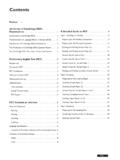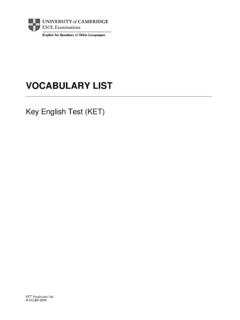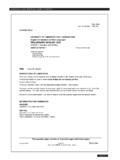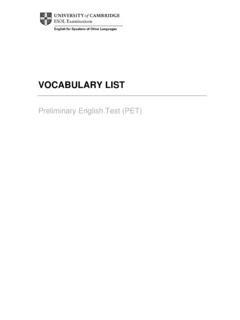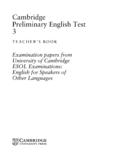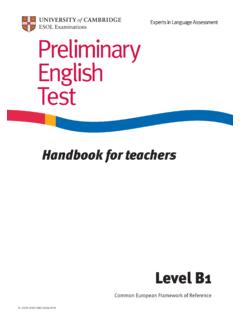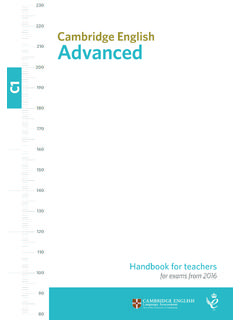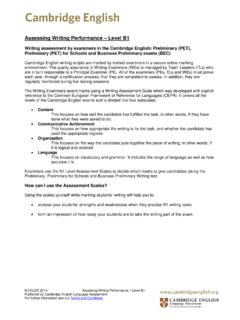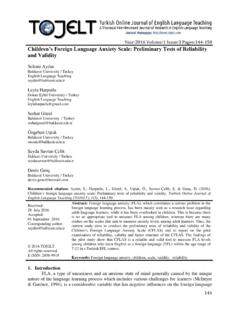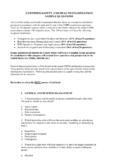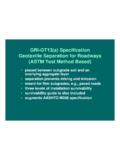Transcription of Experts in Language Assessment Key English Test
1 Experts in Language Assessment Key English Test Handbook for teachers UCLES 2007. EMC/4605/8Y02. The Key English Test is at Level A2 of the Common European Framework of Reference for Languages: Learning, teaching, Assessment published by the Council of Europe KET content and overview Paper Name Timing Content Test Focus Paper 1 Reading/Writing 1 hour 10 minutes Nine parts: Assessment of candidates' ability to understand Five parts (Parts 1 5) test a range of reading the meaning of written English at word, phrase, skills with a variety of texts, ranging from sentence, paragraph and whole text level. very short notices to longer continuous Assessment of candidates' ability to produce texts.
2 Simple written English , ranging from one-word Parts 6 9 concentrate on testing basic answers to short pieces of continuous text. writing skills. Paper 2 Listening 30 minutes Five parts ranging from short exchanges to Assessment of candidates' ability to understand (including longer dialogues and monologues. dialogues and monologues in both informal and 8 minutes, neutral settings on a range of everyday topics. transfer time). Paper 3 Speaking 8 10 minutes per Two parts: Assessment of candidates' ability to answer and pair of candidates in Part 1, candidates interact with an ask questions about themselves and about examiner; factual non-personal information.
3 In Part 2 they interact with another candidate. Preface This handbook is for anyone who is preparing candidates for the Cambridge ESOL Key English Test (KET). The introduction gives an overview of KET and its place within Cambridge ESOL. This is followed by a focus on each paper and includes content, advice on preparation and example papers. Further information on the examination will be issued in the form of: regular update bulletins an extensive programme of seminars and conference presentations. If you require additional CDs or further copies of this booklet, please email: Contents 2 University of Cambridge ESOL 2 Key features of Cambridge ESOL INTRODUCTION TO.
4 Examinations examinations CAMBRIDGE ESOL. 2 Introduction to KET 4 Official accreditation in the UK EXAMINATION CONTENT. 2 Content of KET 4 The KET candidature 3 The level of KET 4 What sort of test is KET? AND PROCESSING. 3 Varieties of English 5 Marks and results 4 Recognition 5 Special circumstances 5 Course materials 5 Seminars for teachers KET SUPPORT. 5 Past papers and examination reports 6 Administrative information 5 Online support 6 Further information 6 Aims and objectives of KET 6 Listening AN OVERVIEW OF KET. 6 Reading 7 Speaking 6 Writing 7 Inventory of functions, notions and 9 Topics Language . communicative tasks 9 Lexis 8 Inventory of grammatical areas SPECIFICATIONS.
5 10 General description 21 Sample scripts test 1. 10. 12. 14. Structure and tasks Preparation Sample paper test 1. 22. 28. 29. Sample paper test 2. Answer keys test 2. Sample scripts test 2. 1. READING AND. 20 Answer keys test 1 30 Answer sheet WRITING PAPER. 31 General description 40 Answer keys test 1. 31. 32. 34. Structure and tasks Preparation Sample paper test 1. 41. 44. 47. Sample paper test 2. Sample tapescript test 2. Answer keys test 2. 2. 37 Sample tapescript test 1 48 Answer sheet LISTENING PAPER. 49 General description 51 Cambridge ESOL Common Scale for 49. 50. 50. Structure and tasks Preparation Assessment Speaking 52 Sample paper 3.
6 SPEAKING. k e t h a n d b o o k f o r te ac h e r s | co nte nts 1. to relate the examinations to the teaching curriculum in Introduction to Cambridge ESOL such a way that they encourage positive learning experiences and to seek to achieve a positive impact University of Cambridge ESOL Examinations wherever possible University of Cambridge ESOL Examinations (Cambridge ESOL) to endeavour to be fair to all candidates, whatever their is a part of the University of Cambridge Local Examinations national, ethnic and linguistic background, gender or Syndicate (UCLES), which has provided examinations in possible disability.
7 English for speakers of other languages since 1913. Cambridge ESOL offers an extensive range of examinations, certificates Cambridge ESOL examinations are designed around four and diplomas for learners and teachers of English . In 2006 over essential qualities: validity, reliability, impact and practicality. 2 million people took these examinations at centres in over Validity is normally taken to be the extent to which a test can 140 countries. be shown to produce scores which are an accurate reflection of the candidate's true level of Language skills. Reliability Cambridge ESOL's systems and processes for designing, concerns the extent to which test results are stable, consistent developing and delivering examinations and Assessment and accurate, and therefore the extent to which they can be services are certified as meeting the internationally depended on for making decisions about the candidate.
8 Recognised ISO9001:2000 standard for quality management. Impact concerns the effects, beneficial or otherwise, which an Cambridge ESOL examinations are suitable for learners of all examination has on the candidates and other users, whether nationalities, whatever their first Language and cultural these are educational, social, economic or political, or various background, and there are examinations suitable for learners combinations of these. Practicality can be defined as the of almost any age. Although they are designed for native extent to which an examination is practicable in terms of the speakers of languages other than English , no Language related resources needed to produce and administer it.
9 All these restrictions apply. The range of Cambridge ESOL examinations factors underpin the development and production of includes specialist examinations in Business English and Cambridge ESOL examinations. English for Academic Purposes, as well as tests for young learners and a suite of certificates and diplomas for Language teachers. Examination content and The examinations cover all four Language skills listening, processing speaking, reading and writing. They include a range of tasks which assess candidates' ability to use English , so that in Introduction to KET. preparing for the examinations, candidates develop the skills they need to make practical use of the Language in a variety of KET was developed between 1991 and 1994, and tests contexts.
10 Above all, what the Cambridge ESOL examinations competence in reading, writing, listening and speaking. It assess is the ability to communicate effectively in English . offers a basic qualification in English and also represents a first step for those wishing to progress towards the Cambridge ESOL is committed to providing examinations of Preliminary English Test (PET). the highest possible quality. This commitment is underpinned by an extensive programme of research and evaluation, and by KET is aligned to the Council of Europe Common European continuous monitoring of the marking and grading of all Framework of Reference (CEFR) for Languages Level A2.
